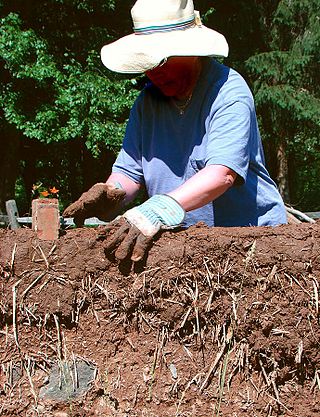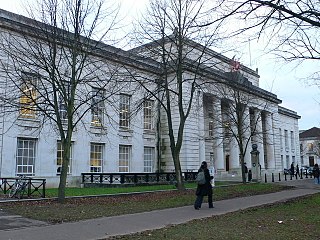
An architect is a person who plans, designs and oversees the construction of buildings. To practice architecture means to provide services in connection with the design of buildings and the space within the site surrounding the buildings that have human occupancy or use as their principal purpose. Etymologically, the term architect derives from the Latin architectus, which derives from the Greek, i.e., chief builder.
The University of Technology Sydney (UTS) is a public research university located in Sydney, New South Wales, Australia. Although its origins are said to trace back to the 1830s, the university was founded in its current form in 1988. As of 2021, UTS enrols 45,221 students through its 9 faculties and schools.

Cob, cobb, or clom is a natural building material made from subsoil, water, fibrous organic material, and sometimes lime. The contents of subsoil vary, and if it does not contain the right mixture, it can be modified with sand or clay. Cob is fireproof, resistant to seismic activity, and uses low-cost materials, although it is very labour intensive. It can be used to create artistic and sculptural forms, and its use has been revived in recent years by the natural building and sustainability movements.

The Royal Institute of British Architects (RIBA) is a professional body for architects primarily in the United Kingdom, but also internationally, founded for the advancement of architecture under its royal charter granted in 1837, three supplemental charters and a new charter granted in 1971.
The Centre for Alternative Technology (CAT) is an eco-centre in Powys, mid-Wales, dedicated to demonstrating and teaching sustainable development. CAT, despite its name, no longer concentrates its efforts exclusively on alternative technology, but provides information on all aspects of sustainable living. It is open to visitors, offers postgraduate degrees as well as shorter residential and one day courses; and publishes information on renewable energy, sustainable architecture, organic farming, gardening, and sustainable living. CAT also runs education programmes for schools and sells environmentally friendly items through its on site shop, restaurant and mail order department.

The Bartlett Faculty of the Built Environment is the academic centre for the study of the built environment at University College London (UCL), part of the University of London in London, United Kingdom. It is home to thirteen departments that have expertise in individual fields of the built environment, including the Bartlett School of Architecture, Bartlett School of Planning, Bartlett Development Planning Unit, and Centre for Advanced Spatial Analysis. The Bartlett is consistently ranked the highest in Europe and the UK and among the highest in the world for the "Architecture and the Built Environment" category in major rankings. It is currently ranked the first in the world for the year 2023.
Ken Yeang is an architect, ecologist, planner and author from Malaysia, best known for his ecological architecture and ecomasterplans that have a distinctive green aesthetic. He pioneered an ecology-based architecture, working on the theory and practice of sustainable design. The Guardian newspaper (2008) named him "one of the 50 people who could save the planet".[ 1] Yeang's headquarters is in Kuala Lumpur (Malaysia) as Hamzah & Yeang, with offices in London (UK) as Llewelyn Davies Ken Yeang Ltd. and Beijing (China) as North Hamzah Yeang Architectural and Engineering Company.

CEPT University, formerly the Centre for Environmental Planning and Technology, is an academic institution located near university area in Ahmedabad, India offering undergraduate, postgraduate and doctoral programmes in areas of natural and developed environment of human society and related disciplines.
Buro Happold Limited is a British professional services firm that provides engineering consultancy, design, planning, project management, and consulting services for buildings, infrastructure, and the environment. It was founded in Bath, Somerset, in 1976 by Sir Edmund Happold when he took up a post at the University of Bath as Professor of Architecture and Engineering Design.

The Welsh School of Architecture (WSA) is an academic school of Cardiff University. It is generally regarded as a world leading school of architecture, and one of the top architecture schools in Britain. In 2019, QS ranked the school immediately behind Ivy League school Princeton and ahead of Pennsylvania and Yale. The Welsh School of Architecture is currently listed as number 3 in the UK by The Guardian Rankings, number 5 by the complete university guide, and number 5 in the UK by the QS Subject rankings.
Grimshaw Architects is an architectural firm based in London. Founded in 1980 by Nicholas Grimshaw, the firm was one of the pioneers of high-tech architecture. In particular, they are known for their design of transport projects including Amsterdam Bijlmer ArenA railway station, Waterloo International railway station and the award-winning Southern Cross railway station which was the recipient of the Royal Institute of British Architects Lubetkin Prize. Grimshaw is behind the design of the Sustainability Pavilion, an innovative net-zero building, for Expo 2020. The firm currently has offices in Los Angeles, New York, London, Paris, Dubai, Melbourne and Sydney, employing over 600 staff.
Rick Mather was an American-born architect working in England. Born in Portland, Oregon and awarded a B.arch. at the University of Oregon in 1961, he came to London in 1963 and worked at the architectural firm Lyons Israel Ellis for two years. He became a leading figure at the Architectural Association in the 1970s, and in 1973 founded his own practice, Rick Mather Architects.
William Robert Dunster OBE is a British architect.

John Renwick McAslan is a British architect.
The Cambridge Institute for Sustainability Leadership, formerly the Cambridge Programme for Sustainability Leadership and the Cambridge Programme for Industry, is part of the School of Technology within the University of Cambridge.

Page\Park Architects was established in 1981 by David Page and Brian Park and has developed as one of Scotland's best known practices undertaking work over a range of sectors.

David Lloyd Jones AA DIP, RIBA, FRSA is a founding partner of Studio E LLP, an architectural practice established in London in 1994. He has been described as "a godfather of the sustainable architecture movement in the UK". Lloyd Jones has been heavily involved in both promoting 'green' design and demonstrating it in practice. He has been responsible for a series of seminal bioclimatic buildings, including the National Farmers Union and Avon Insurance Head Office at Stratford upon Avon; the Solar Office Doxford International near Sunderland; Beaufort Court Zero Emissions Building at Kings Langley; Grange Park Opera House and the current new campus for The British College in Kathmandu. His book, Architecture and the Environment, was published in 1998. He is a founding member and chair of the charity Climate Change All Change.

Sir Alexander John Gordon, CBE was a Welsh architect. Born in Ayr, Scotland, he was brought up and educated in Swansea and Cardiff. After World War II he designed several major buildings in Cardiff and Swansea, and from 1971 to 1973 he served as president of the Royal Institute of British Architects. In 1974 he summarised the needs of new architecture as 'Long life, loose fit, low energy'.
Justin Bere is a British architect based in London. He is founder of his own practice bere:architects and has developed a specialism in low energy passive house (Passivhaus) buildings, resulting in the first certified passive house building in London in 2010. In 2012 he was named one of the most influential people in UK sustainability by Building Design magazine.

Waste House is a building on the University of Brighton campus in the centre of Brighton on the south coast of England. It was built between 2012 and 2014 as a project involving hundreds of students and apprentices and was designed by Duncan Baker-Brown, an architect who also lectures at the university. The materials consist of a wide range of construction industry and household waste—from toothbrushes and old jeans to VHS cassettes and bicycle inner tubes—and it is the first public building in Europe to be built primarily of such products. "From a distance [resembling] an ordinary contemporary town house", Waste House is designed to be low-energy and sustainable, and will be in continuous use as a test-bed for the university's design, architecture and engineering students. The building has won several awards and was shortlisted for the Royal Institute of British Architects' Stephen Lawrence Prize in September 2015.











